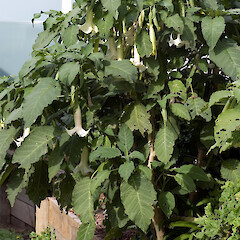Brugmansia ×candida
Common name
angel’s trumpet
Synonyms
Brugmansia candida Pers.
Family
Solanaceae
Flora category
Vascular – Exotic
Structural class
Trees & Shrubs - Dicotyledons
Conservation status
Not applicable
Habitat
A frost-tender plant mainly found in lowland areas towards the coast (Landcare Research 1999).
Detailed description
Soft-wooded shrub, 3m high. Leaves 8-20 x 3-25 cm, plant is covered in very fine hairs. White, pendant, trumpet-like flowers 20-30 cm long. Fruit is occasionally produced.
Similar taxa
Brugmansia species are often confused with Datura species (due to the common name) however, Brugmansia species are soft-wooded shrubs or small trees, while Datura species are herbaceous. B. candida is very similar to B. suaveolens but can be separated by the persistently hairy leaves. B. sanguinea is also similar but has yellow flowers which are often tinged red.
Flower colours
White
Year naturalised
1958
Origin
Probably Peru and Columbia
Etymology
brugmansia: Named after Sebald Justin Brugmans (24 March 1763 – 22 July 1819) who was an early 18th century professor of natural history at the University of Leydon. He was also a military physician and instrumental in establishing emergency hospital facilities and improvement of hospital and barrack conditions.
candida: White
Life Cycle Comments
Believed to be mostly spread by cuttings so seed set is rare.
Reproduction
Mostly vegetative, some seed.
Seed
rare
Dispersal
People, birds.
Poisonous plant:
All parts of this plant are poisonous.



